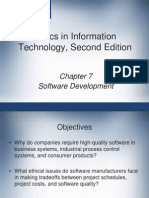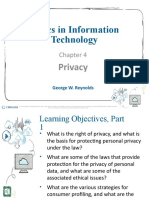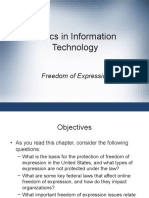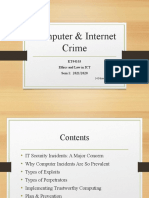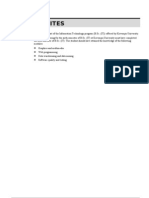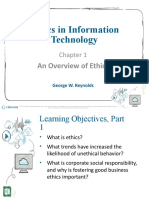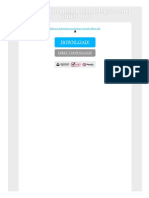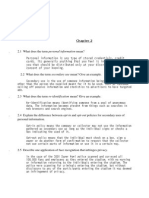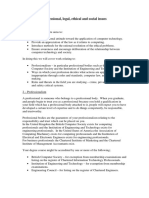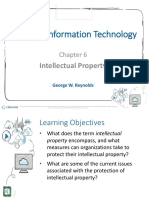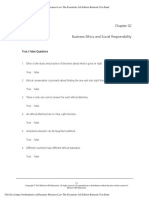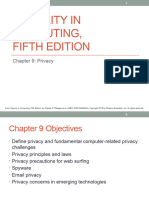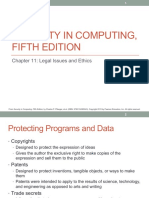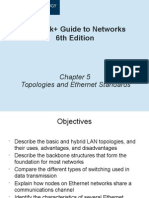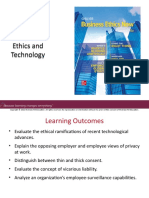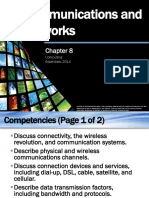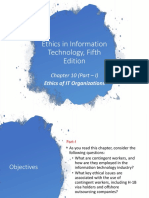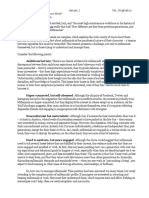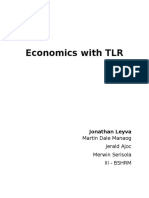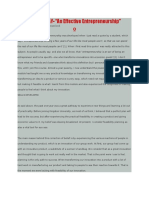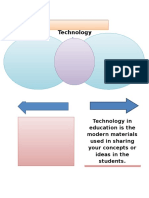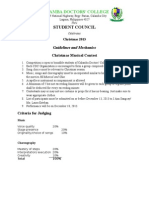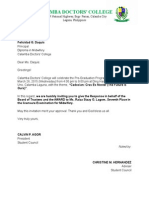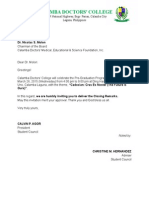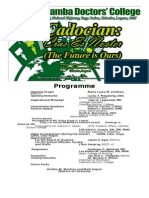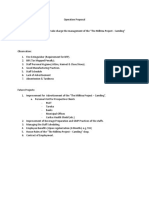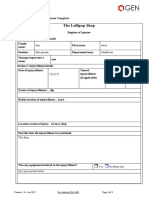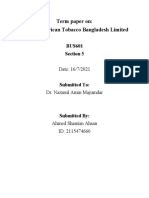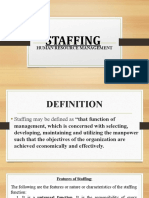Ethics in Information
Technology, Fourth Edition
Chapter 10
Ethics of IT Organizations
�Objectives
As you read this chapter, consider the following
questions:
What are contingent workers, and how are they
employed in the information technology industry?
What key ethical issues are associated with the use
of contingent workers, including H-1B visa holders
and offshore outsourcing companies?
What is whistle-blowing, and what ethical issues are
associated with it?
Ethics in Information Technology, Fourth Edition
�Objectives (contd.)
What is an effective whistle-blowing process?
What measures are members of the electronics
manufacturing industry taking to ensure the ethical
behavior of the many participants in their long and
complex supply chains?
What is green computing, and what are organizations
doing to support this initiative?
Ethics in Information Technology, Fourth Edition
�Key Ethical Issues for Organizations
Ethical topics are pertinent to organizations in the
IT industry and organizations that make use of IT
Use of nontraditional workers
Whistle-blowing
Green computing
ICT code of ethics
Ethics in Information Technology, Fourth Edition
�The Need for Nontraditional Workers
Bureau of Labor Statistics (BLS) forecast
Network systems and data communications analysts
will be 2nd fastest growing occupation from 20082018
Employment of computer software engineers will
grow 34%
Concern about a shortfall in the number of U.S.
workers to fill these positions
Several IT positions in the top-ten paid majors for
2010-2011 bachelors degree graduates
Ethics in Information Technology, Fourth Edition
�The Need for Nontraditional Workers
(contd.)
Long-term shortage of IT workers
Employers turning to nontraditional sources
Sources include:
Contingent workers
H-1B workers
Outsourced offshore workers
Ethical decisions about whether to:
Recruit new/more workers from these sources
Develop their own staff to meet their needs
Ethics in Information Technology, Fourth Edition
�Contingent Workers
Contingent work is a job situation in which an
individual does not have an explicit or implicit
contract for long-term employment
Contingent workers include:
Independent contractors
Temporary workers through employment agencies
On-call or day laborers
On-site workers provided by contract firms
Needed for pronounced IT staffing fluctuations
Workers hired for the life of the project only
Ethics in Information Technology, Fourth Edition
�Contingent Workers (contd.)
Sources
Temporary agencies
Employee leasing
Consulting organizations
Firms that provide temporary help:
Recruit, train, and test their employees in a wide
range of job categories and skill levels
Assign them to clients
Ethics in Information Technology, Fourth Edition
�Ethics in Information Technology, Fourth Edition
�Contingent Workers (contd.)
Employee leasing
Business outsources all or part of its workforce to a
professional employer organization
Subject to special regulations regarding workers
compensation and unemployment insurance
Coemployment relationship
Two employers have actual or potential legal rights
and duties with respect to the same employee or
group of employees
Ethics in Information Technology, Fourth Edition
10
�Contingent Workers (contd.)
Advantages of using contingent workers
Business does not pay for benefits
Can continually adjust the number of contingent
workers to stay consistent with its business needs
Does not customarily incur training costs
Ethics in Information Technology, Fourth Edition
11
�Contingent Workers (contd.)
Disadvantages of using contingent workers
Workers may lack a strong relationship with the firm
Low commitment to the company and its projects
High turnover rate
Workers gain valuable practical experience working
within a companys structure and culture
Lost when workers depart at the projects completion
Ethics in Information Technology, Fourth Edition
12
�Contingent Workers (contd.)
When deciding to use contingent workers:
Recognize the trade-off between:
Completing a single project quickly and cheaply
Developing people in the organization
When staffing is truly temporary:
Use of contingent workers is a good approach
Think twice about using contingent workers:
When they are likely to learn corporate processes and
strategies that are key to the companys success
Workers next assignment may be with major
competitor
Ethics in Information Technology, Fourth Edition
13
�Contingent Workers (contd.)
Deciding when to use contingent workers
Can raise ethical and legal issues
Potential liability for:
Withholding payroll taxes
Payment of employee retirement benefits
Payment of health insurance premiums
Administration of workers compensation
Ethics in Information Technology, Fourth Edition
14
�Contingent Workers (contd.)
Deciding when to use contingent workers (contd.)
Can be viewed as permanent employees by:
Internal Revenue Service
Labor Department
State workers compensation agency
State unemployment agencies
Vizcaino v. Microsoft lawsuit
Deciding factor is degree of control company
exercises over employees
Employers must exercise care in the treatment of
contingent workers
Ethics in Information Technology, Fourth Edition
15
�Ethics in Information Technology, Fourth Edition
16
�H-1B Workers
Temporary work visa
U.S. Citizenship and Immigration Services (USCIS)
For people who work in specialty occupations
H-1B workers
Meet critical business needs
Have essential technical skills and knowledge not
readily found in the U.S.
Employers must pay H-1B workers the prevailing
wage for the work being performed
Ethics in Information Technology, Fourth Edition
17
�H-1B Workers (contd.)
Maximum continuous period of six years
After six years, the foreign worker must remain
outside the United States for one year before
another H-1B petition can be approved
Continued use of H-1B workers
Symptom of a larger, more fundamental problem
U.S. not developing sufficient IT employees
Ethics in Information Technology, Fourth Edition
18
�H-1B Workers (contd.)
Top five outsourcing countries
India
China
Canada
Philippines
Korea
Federal cap of 65,000 for number of H-1B visas
Applies only to certain IT professionals
Large number of workers are exempt from cap
Ethics in Information Technology, Fourth Edition
19
�H-1B Workers (contd.)
English as a second language
Workers who are not fluent in English:
May find it difficult and uncomfortable to participate
May create their own cliques
May stop trying to acclimate
Can hurt a project teams morale and lead to division
Managers and coworkers should:
Strive to help improve H-1B workers English skills
and cultural understanding
Be sensitive to workers heritage and needs
Ethics in Information Technology, Fourth Edition
20
�H-1B Workers (contd.)
H-1B application process
Employer making job offer must also offer
sponsorship
Application has two stages
Labor Condition Attestation (LCA)
H-1B visa application
If H-1B are more than 15% percent of companys
workforce:
Must prove that it first tried to find U.S. workers
Must prove not hiring H-1B after laying off similar U.S.
worker
Ethics in Information Technology, Fourth Edition
21
�H-1B Workers (contd.)
American Competitiveness in the Twenty-First
Century Act (2000)
Allows current H-1B holders to start working for
employers as soon as their petitions are filed
Using H-1B workers instead of U.S. workers
Good for short-term hiring
Long-term hiring
Lessens incentive to educate and develop U.S.
workforces
Does nothing to develop strong core of permanent
U.S. IT workers needed in future
Ethics in Information Technology, Fourth Edition
22
�H-1B Workers (contd.)
Potential exploitation of H-1B workers
Salary abuse by unethical companies
Some H1-B workers are paid $10,000 to $30,000
less than U.S. workers in the same job
Visa Reform Act (2004)
Defined a modified wage-rate system
At end of the six-year visa term:
If no green card, firm loses worker
Suddenly unemployed worker must return home
Ethics in Information Technology, Fourth Edition
23
�B - 1 Visa Controversy
B-1 visitor visa for people who wish to enter U.S.
temporarily:
For pleasure or medical treatment
To travel for short periods of time to consult with
business associates; attend convention or
conference; negotiate a contract; or install or
maintain machinery
B-1 visa faster, easier, and cheaper to obtain
Lot of gray area in the use of B-1 visas
Ethics in Information Technology, Fourth Edition
24
�Outsourcing
Outsourcing
Approach to meeting staffing needs
Long-term business arrangement
Company contracts with an outside organization that
has expertise in providing a specific function
Rationale
Coemployment legal problems are minimal
Lower costs
Obtain strategic flexibility
Keep staff focused on core competencies
Ethics in Information Technology, Fourth Edition
25
�Offshore Outsourcing
Variation of outsourcing
Services provided by an organization whose
employees are in a foreign country
Companies reduce labor costs
Increasing in IT industry
As key processes move offshore, U.S. IT providers
are forced to lower prices
Common to use offshore outsourcing for major
programming projects
Ethics in Information Technology, Fourth Edition
26
�Offshore Outsourcing (contd.)
Ethics in Information Technology, Fourth Edition
27
�Offshore Outsourcing (contd.)
Ethics in Information Technology, Fourth Edition
28
�Offshore Outsourcing (contd.)
Ethics in Information Technology, Fourth Edition
29
�Offshore Outsourcing (contd.)
Pros and cons of offshore outsourcing
Low wages
Demand for offshoring driving up salaries
Dramatically speeds up development efforts
Make progress on a project around the clock
Can also result in new expenses
Additional time to select an offshore vendor
Additional costs for travel and communications
Same ethical issues as H1-B and contingent workers
Difficulty of communications over long distances and
differences in culture and language
Ethics in Information Technology, Fourth Edition
30
�Offshore Outsourcing (contd.)
Strategies for successful offshore outsourcing
Expertise in technologies involved in the project
Project manager speaks native language of
employer
Large staff available
State-of-the-art telecommunications setup
High-quality on-site managers and supervisors
Ethics in Information Technology, Fourth Edition
31
�Whistle-Blowing
Effort to attract public attention to a negligent,
illegal, unethical, abusive, or dangerous act by a
company
Whistle-blower
Usually has personal or special knowledge
Risks own career
Might even affect lives of friends and family
Must choose between protecting society and
remaining silent
Ethics in Information Technology, Fourth Edition
32
�Whistle-Blowing (contd.)
Protection laws allow employees to alert authorities
to employer actions that are unethical, illegal, or
unsafe or that violate specific public policies
No comprehensive federal law
Each law has different:
Filing provisions
Administrative and judicial remedies
Statutes of limitations
Ethics in Information Technology, Fourth Edition
33
�Whistle-Blowing (contd.)
False Claims Act (Lincoln Law)
Enacted during the Civil War
Enticed whistle-blowers to come forward
Offered a share of the money recovered
Qui tam provision allows private citizen to file in
name of government
Violators are liable for three times the dollar
amount the government is defrauded
Provides strong whistle-blower protection
Complexity requires advice of an attorney
Ethics in Information Technology, Fourth Edition
34
�Whistle-Blowing (contd.)
Whistle-blower protection for private-sector workers
Many states, not all, have laws that prevent workers
from being fired because of an employees
participation in protected activities
Whistle-blowers can file claims against their
employers for retaliatory termination
Whistle-blowers are entitled to jury trials
If successful at trial, can receive punitive damage
awards
Ethics in Information Technology, Fourth Edition
35
�Whistle-Blowing (contd.)
Dealing with a whistle-blowing situation
Assess the seriousness of the situation
Begin documentation
Attempt to address the situation internally
Consider escalating the situation within the company
Assess implications of becoming a whistle-blower
Use experienced resources to develop action plan
Execute the action plan
Live with the consequences
Ethics in Information Technology, Fourth Edition
36
�Green Computing
To manufacture truly green products, companies
must:
Produce product that requires less electricity
Reduce the amount of hazardous materials used
Increase amount of reusable or recyclable materials
Help consumers dispose of their products in an
environmentally safe manner at the end of the
products useful life
Ethics in Information Technology, Fourth Edition
37
�Green Computing (contd.)
Personal computers and cell phones contain
thousands of components composed of many
different materials
Some harmful to humans and environment
Workers along the entire supply chain at risk
Users can also be exposed to these materials
Ethics in Information Technology, Fourth Edition
38
�Green Computing (contd.)
EPEAT (Electronic Product Environmental
Assessment Tool)
Enables purchasers to evaluate, compare, and
select electronic products
Based on a total of 51 environmental criteria
Products are ranked in three tiers of environmental
performance
European Restriction of Hazardous Substances
Directive
Restricts use of many hazardous materials in
computer manufacturing
Ethics in Information Technology, Fourth Edition
39
�Green Computing (contd.)
How to safely dispose of obsolete computers
Many states have recycling programs
Some manufacturers have developed programs
Greenpeace environmental activist organization
Issues quarterly ratings of manufacturers according
to the manufacturers policies on toxic chemicals,
recycling, and climate change
Manufacturers have long way to go to meet the high
standards
Ethics in Information Technology, Fourth Edition
40
�ICT Industry Code of Conduct
Electronic Industry Citizenship Coalition (EICC)
Promotes common code of conduct for ICT industry
Focuses on the areas of:
Worker safety and fairness
Environmental responsibility
Business efficiency
Coalition membership is voluntary
Code of conduct defines performance, compliance,
auditing, and reporting guidelines across five areas
of social responsibility
Ethics in Information Technology, Fourth Edition
41
�ICT Industry Code of Conduct (contd.)
Guiding principles of social responsibility
Labor
Must uphold the human rights of workers
Health and safety
Must provide safe and healthy work environment
Environment
Adverse effects minimized
Management system
Ensures compliance with code
Ethics
Must uphold the highest standards of ethics
Ethics in Information Technology, Fourth Edition
42
�Summary
Contingent workforce includes:
Independent contractors
Temporary workers through employment agencies
On-call or day laborers
On-site workers provided by contract firms
Outsourcing
Long-term business arrangement
Contract for services with outside organization
Expertise in providing a specific function
Ethics in Information Technology, Fourth Edition
43
�Summary (contd.)
Whistle-blowing
Effort to attract public attention to negligent, illegal,
unethical, abusive, or dangerous acts by company
Whistle-blowing process
Assess the seriousness of the situation
Begin documentation
Attempt to address the situation internally
Consider escalating the situation within the company
Assess the implications of becoming a whistle-blower
Use experienced resources to develop an action plan
Execute the action plan
Live with the consequences
Ethics in Information Technology, Fourth Edition
44
�Summary (contd.)
Green computers
Use less electricity
Include fewer hazardous materials
Contain reusable or recyclable material
Manufacturers must help consumers:
Dispose of products in an environmentally safe
manner at the end of the products useful life
EPEAT (Electronic Product Assessment Tool)
Purchasers can evaluate, compare, and select
Based on 51 environmental criteria
Ethics in Information Technology, Fourth Edition
45




